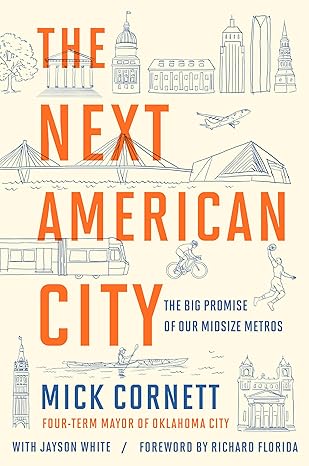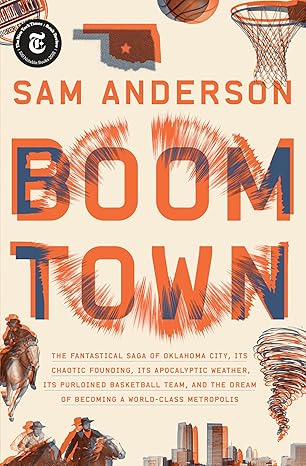Can an American city confirm and shatter preconceived notions, all at the same time? That’s the question I found myself asking when, in 2019, I used my personal tourism fund to explore Oklahoma City.
Leading up to the trip, I had become intrigued by the city and its mindboggling trajectory from an American wasteland to the next big thing. I wasn’t alone, as two recent books, one by a former mayor and the other by a New York-based writer, had found prominent placement on national bookshelves.
I devoured both reads and felt equipped to tackle Oklahoma’s capital.
Granted, I knew that any amount of reading couldn’t replace personal experience, especially when the sources were a city booster and a gifted storyteller. Both might be predisposed to overstatement, and the truth would be more balanced, if not just mundane.
Or so I thought.
Oklahoma City, I learned, is a land of contradiction, one that—to answer my question—can both cement and demolish stereotypes. And its ability to do so, it turns out, doesn’t discriminate by sector.
Education and Culture
Oklahoma, as a state, is not typically branded as a haven for artists and intellectuals. Yet my tour of its most populous city began at the Oklahoma City Museum of Art, home to one of the largest collections of Dale Chihuly glass in the world. A popular exhibit featured striking photographs of the West, courtesy Anselm Adams, and works by Van Gogh, Monet, and Degas were slated for future display.
After hitting the museum bar (fantastic, by the way), the next stop was an independent bookstore. In true indie fashion, the collection of contemporary books had been meticulously curated. The goal, it seemed, was enlightenment, whether or not that mission translated into copious sales.
Looking to keep the momentum going, I headed to the Oklahoma History Center. It was there, however, that I was reminded that I was in a state where every single county had voted red in the preceding presidential election. (Even the county with the University of Oklahoma had gone in that direction by a margin of 21 percent.) An exhibit on Native American history highlighted the Christianity of modern Native Americans, a seemingly trivial part of their overall narrative. More peculiar was a list of reasons why they had adopted Christianity, the leading explanation being that they had simply discovered the proper path.
An exhibit on the history of oil and gas was located adjacent to a list of major donors, with local energy companies leading the way. It follows, then, that the nearest mention to alternative energy was natural gas. As if to drive home the message, an oil rig worked diligently just outside the museum’s main entrance.
Transportation
Enjoy a ride in a water taxi as it maneuvers through vibrant restaurants, live music venues, and your favorite watering holes. Ditch the car and explore the city via streetcar—with 22 stops and an all-day fare of three dollars, you may never want to drive again. Don’t forget your bike for your jaunt on the river, also known for its world-class rowing. And wear comfortable shoes—this place is seriously walkable.
The above could be a reasonable plug for Oklahoma City. Yes, that Oklahoma City.
But before you get too excited, know the following: The city spans over 600 square miles, much of that being an endlessly flat mix of six-lane roads and strip malls. Any hope of traversing the area in a timely fashion will involve an automobile, preferably—as per my observations—a pickup truck or SUV.
And don’t be fooled by the metro area population of 1.4 million. Spread over 6,359 square miles, the population density is just 221.6 residents per square mile. Compare that to the 718 per square mile of another reputationally challenged region—Buffalo.
Food and Beverage
As my brief introduction at the art museum showed, Oklahoma City knows its victuals. The city is dotted with microbreweries, perhaps not a revelation given a similar trend nationally. That said, the creative spaces in Oklahoma City would be creative anywhere. Third-wave coffee shops offer a portal to Portland, Oregon, as do the thick-framed eyeglasses of their customers. The best restaurants in town would thrive in New York City. Vegetarian and vegan options abound, dismantling the myth of mandatory carnivorism.
But don’t be misled. A complete tour of the city involves fast food—and lots of it. Sonic, which is headquartered locally, makes a frequent appearance. Expect to see six or seven rival establishments in sequence, with the healthiest option nearby being the produce aisle at Walmart. As a state, Oklahoma has 5.3 fast food restaurants per 10,000 residents, tied for third in the country. In other words, it’s easy to see how the state has played a leading role in the country’s obesity epidemic.
Economy
Oklahoma City is going places. From 2010 to 2020, the city’s population increased by over 100,000 residents and has since crossed the 700,000 mark. Economic progress is obvious, on full display in the form of new construction. The northwest section of the city would cater to the highest of tastes, anchored by the posh Nichols Hills (technically its own city), which boasts a per-capita income among the highest in Oklahoma. Nearby, Trader Joe’s, Whole Foods, and the sparkling campus of Chesapeake Energy complete the picture. Disposable income, it seems, is not an issue.
But a visit south of the Oklahoma River paints a different picture, one of American poverty, if not hopelessness. The seeds and results of the opioid crisis are in plain view. Gentrification is hardly even a pipe dream. The eastern part of town is predominantly African American, home to a patch where urban meets rural and economic vibrancy is a foreign language. That is, of course, unless we include the aforementioned fast food establishments.
***
In Oklahoma City, the highlights are remarkably high, and the lowlights are startlingly low. It is a land of passions, even when those passions are in open and direct conflict with each other. But underlying the contradictions is one constant—a populace that has worked together to create a story worth telling. And for that reason, despite the uninformed voices that might have told us otherwise, the eclectic—or perhaps eccentric—Oklahoma City should have our attention.
In retrospect, I should not have been surprised by this realization. My tour guide, after all, was my cousin who had immigrated to Oklahoma City from Mumbai two decades earlier.
He had left one of the world’s largest cities, a booming metropolis on the Indian coast, for what was then an uninspiring, dusty patch in America’s heartland.
He became a climate-focused liberal in a city built on fossil fuel.
He embraced the bicycle in a region built for four (or more) wheels.
He is, to this day, often the only tinted individual in the places he frequents.
He is an agnostic in the Bible Belt.
And he is an ardent supporter of his adopted hometown.
Therein lies the compelling paradox that is Oklahoma City.
(This article was based on an original version written on April 8, 2019.)


4 Responses
Go Sooners !! Thunder up !!!!
Hahaha. Heck yeah!!
most southern cities are booming and are conservative with a few exceptions like your tour guide.
Very true. As long as the non-conservative voices are given a seat at the table, I’m all in.